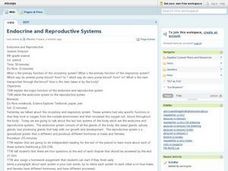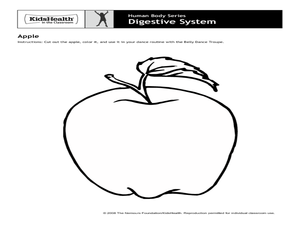Bozeman Science
Reproductive System
The human reproductive system contains the largest (egg) and smallest (sperm) cells in the human body. It's time for scholars to review the differences between asexual and sexual reproduction. The instructor reminds them how meiosis...
Curated OER
Human Reproduction: Fertilization and Fetal Development
The journey of a fertilized egg is illustrated as it travels from the fallopian tube to the uterus. Cell division is explained and the miracle of life is shown.
Curated OER
Human Development
Three-dimensional animation zooms in on human development as it begins in the female ovaries. The animated egg changes and forms as you watch it travel down the fallopian tube into the uterus.
Curated OER
We've Come a Long Way, Baby!
Pupils study technology and the different reproductive technologies available today. In this human reproductive technology lesson students describe how engineers create technologies to improve the health of mothers and babies.
Curated OER
The Human Genotype
Six different chromosome activites introduce biology aces to heredity, chromosomal abnormalities, sex-linked traits, and the human genome. The hands-on activites are fairly simple for the teacher to prepare and will prove to be both...
King County
Reproductive System
It's every health and science teacher's favorite subject to cover: the reproductive system. This comprehensive lesson introduces adolescents to the reproductive anatomy of men and women with the help of a series of diagrams, discussions,...
Howard Hughes Medical Institute
Human Chromosomes
Learn a little about what makes humans unique. Young scholars view a video lesson as an introduction to chromosome pairs. Images show pairs of chromosomes including the XX or XY sex chromosome combinations.
Curated OER
The Female Reproductive System
Students research female reproductive issues. They create a presentation, in small groups, that focuses on one particular helath issue involving the female repro=ductive system.
Curated OER
Endocrine And Reproductive Systems
Pupils investigate the hormonal levels that are created with the endocrine system and tie it to the act of sexual reproduction. The lesson discusses how the respiratory system is organized as a comparison to the endocrine system which is...
Curated OER
Human Embryo Development and Birth Defects
Open this lesson with a discussion on birth defects. Break the class into groups to visit a website and learn about what happens at each stage of human embryo and fetal development. Assign each group a particular birth defect to...
Curated OER
Physiology of Reproduction
In this health worksheet, students examine the human body and make mental connections to the target function highlighted in the sheet.
Curated OER
Anatomy and Physiology
Fifth graders work in teams to play a game enabling them to identify the basic components of the female human reproductive system. They view an overhead that describes menstruation and discuss their knowledge of the female reproductive...
Amoeba Sisters
Human Body Systems: The 11 Champions
An informative video offers a brief overview of the 11 systems in the human body. It gives a brief description of each before pointing out their interdependence.
Bozeman Science
Stickleback Evolution
About 70 percent of the genes of the stickleback fish are the same as humans. In the video, scholars further explore the stickleback fish and its history, from being removed from Loberg Lake to their change and comeback. Over time, these...
Curated OER
Life Cycle- The Human Body
Seventh graders examine the life cycle of the human. In this human life cycle activity, 7th graders discuss the many different stages of the human life cycle. Students use pictures from magazines to create a representation of the human...
Curated OER
Human Body Series - Cardiovascular System
Pump up your class while studying the cardiovascular system with this pair of activities. In one, learners record heart rates during different actions. In the second, they read kid-friendly heart health articles online and then write a...
Curated OER
Human Body Series - Digestive System
With articles entitled, "What's Puke?" and "What is a Fart?" this digestive system lesson plan is sure to be a gas! Elementary anatomists do a belly dance to illustrate how food moves through the digestive system and then design a board...
Curated OER
The First Few Weeks
As the title implies, the first few weeks of a baby's development are shown in the animated video. From its beginnings as a blastocyst to cell differentiation and intense development, see just how complex reproduction and the beginning...
Curated OER
Human Cloning: Is it Biological Plagiarism?
Is cloning good or harmful? Help your class understand the risks and benefits as they read, research, and discuss human cloning. Individuals form teams, research information, and present to the class before concluding with an in-depth...
Curated OER
STEMbite: Seed Dispersal
Dandelion and maple tree seeds are blown and thrown to show two methods of seed dispersal. The narrator videotapes from his vantage point, his hands visible, but never his face. He examines helicopter blades as a human imitation of maple...
Be Smart
Why Do Disney Princesses All Look like Babies?
Could Disney be tricking people into caring about their characters? It seems the design of characters in recent years triggers our nurturing instincts. A video explains the science behind these instinctual habits—and why viewers are so...
Channel Islands Film
Natural Resources, and Human Uses of Plants and Animals
As part of their study of the restoration projects on Santa Cruz Island, class members demonstrate their understanding of the connections among plant life, animals, and the actions of humans by crafting a model that reveals these...
Personal Genetics Education Project
Genetics and Reproduction
Disease prevention or designer babies? Use a set of slides to introduce the growing practice of preimplantation genetic diagnosis, or PGD. Teens read related articles and then break into groups to address different scenarios. Afterward,...
Curated OER
Variation in Human Skin Color
Students explore factors that control variation in human skin color and the implications of this information for human society. They understand that skin color is no longer considered a credible scientific standard by which to classify...

























